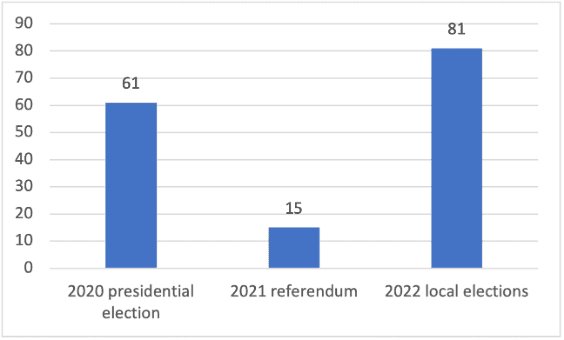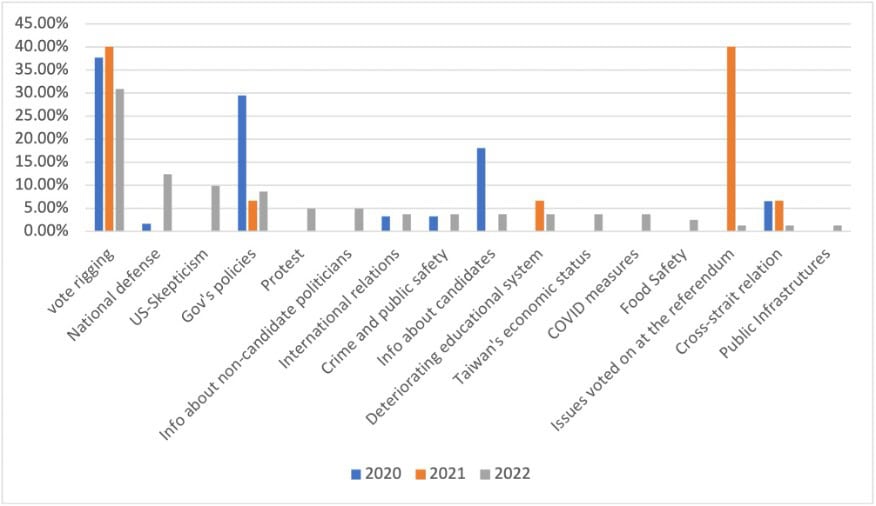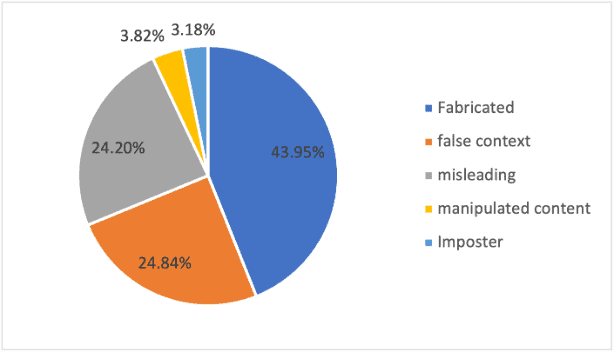Image: A woman walk out of the voting booth on election day in Taipei, Taiwan, November 26, 2022. (Top Image)
By Wei-Ping Li, PhD
As the next Taiwanese presidential election approaches in January 2024, the Taiwanese face another wave of disinformation to influence voters. Learning from historical trends and comparing them with what the Taiwan FactCheck Center (TFC) has observed so far in 2023 could help us to identify disinformation campaigns targeting the upcoming election.
In the first installment of our series on disinformation challenges of the 2024 Taiwanese presidential election, we look at the general pattern of disinformation narratives in the 2020 presidential election, 2021 Taiwanese referendum, and 2022 local elections.
? Background of the elections in 2020, 2021, 2022, and the data of this analysis
Taiwan has had elections or referendums every year in recent years. In 2020, Tsai Ing-wen, the then-incumbent Taiwanese president who promised to safeguard Taiwan’s sovereignty, beat Kuomintang (KMT) party candidate Han Kuo-yu, who advocated a stronger relationship with China. Taiwan held a referendum in late 2021 to decide on four public policy issues, including the activation of a nuclear power plant, a ban on importing ractopamine-containing pork, future referendum dates, and algal reef conservation. In December 2022, Taiwanese residents chose city mayors, county chiefs, and local councilors. Despite the fact that these elections were for local posts, they were positioned as alternative, although imperfect, indices of Taiwanese attitudes toward political parties and the current central government leadership. As a result, it’s not surprising that voters saw disinformation on subjects relating to the central government’s duties, such as national defense, even in local elections.
Based on fact-checking reports issued by TFC during the seven months (including the month that the election was held) before each election, we investigated trends of election disinformation over the past three years and identified common narratives of them. For example, for the 2020 presidential election, which was held on January 11, 2020, we reviewed fact-checks from July 2019 to January 2020 that are related to the elections and Taiwanese society and politics. In the end, we examined 157 relevant fact-checking reports done during the seven-month periods of the three years. All the information pieces checked in these 157 reports are incorrect or partially incorrect and have been spread in the Taiwanese social media or mainstream media.
We also wanted to point out that this investigation may not encompass ALL the disinformation pieces disseminated during the elections. Nonetheless, it offers a look into a number of noteworthy characteristics of disinformation that were prevalent during the elections, with a particular emphasis on narratives.

? “Vote rigging” is the most common category of disinformation
Figure 2 illustrates the percentage of various disinformation topics in the 157 TFC fact-checking reports. The topic “vote rigging” appears most frequently in the disinformation reviewed, followed by mischaracterizations of government policies and inaccurate information regarding presidential and local candidates. False information concerning Taiwan’s national security and those aiming to incite mistrust about the U.S., such as that the U.S. was encouraging a conflict between China and Taiwan, account for 7.01% and 5.01%, respectively. Furthermore, there was disinformation produced to incite anger about Taiwanese individuals’ everyday life, such as false information suggesting deterioration in public safety and education. Some disinformation pieces used authentic pictures to convey false messages, claiming that mainstream media purposely failed to cover large-scale street protests and hindered information dissemination. These categories of disinformation content will be explored further in this series of analyses.

? The topics of disinformation targeting elections have become more diverse
Figure 3, which demonstrates the wax and wane of disinformation topics over the past three years, illuminates some interesting trends. First of all, vote rigging has remained the top disinformation category in all three years. Secondly, there is an intriguing trend that the categories of disinformation have become more diverse if comparing the categories across the three elections and referendum.
In the 2020 presidential election, the disinformation attacks concentrated on vote rigging, the government’s policies, and information about presidential candidates, whereas the 2021 referendum saw more disinformation on vote rigging and referendum issues. However, although education and cross-strait relations between Taiwan and China were not the issues to be voted on in 2021, they were still part of the disinformation campaign. For example, one of the disinformation pieces showed a video claiming that the Chinese government sided with the KMT party on the referendum issues – which was incorrect since the video was a clip analyzing KMT’s arguments on the referendum issues and did not touch on the attitude of the Chinese government. However, this disinformation piece could impress audiences that the KMT colluded with China.
The categories of disinformation were even more diversified in the 2022 local elections: while vote rigging still remained the top disinformation, disinformation about Taiwan’s national defense and skepticism toward the U.S. rose to the second and third common categories. At first glance, it seemed unusual that disinformation about national defense and relations with the U.S. became prominent during local elections. However, given that then-U.S. House Speaker Nancy Pelosi visited Taiwan in August 2022 and China’s subsequent response to conduct military exercises circling Taiwan, it makes sense that the sentiments sparked by the two related events continue to reverberate throughout the Taiwanese public and were reflected in public discourse, including disinformation during local elections.

In addition to national defense and U.S. skepticism, COVID-19, of which the infections and restrictions had gradually tapered off in September 2022, was still an ingredient for disinformation in the 2022 local election. [1] For example, one disinformation piece claimed that the death rate of COVID-19 in Taiwan was high due to the government’s failure. Another piece stated that there was an outbreak of COVID-19 due to inappropriate testing measures in the airport. These disinformation pieces were actually intended to discredit Taipei mayor candidate Chen Shih-chung, who served as Minister of Health and Welfare during COVID-19 and then ran for Taipei Mayor election campaign for the Democratic Progressive Party (DPP).
President Tsai Ing-wen was also the subject of disinformation during the 2022 local elections. These disinformation pieces falsified celebrity quotes or used unrelated videos to depict Tsai as a president who prepared to escape Taiwan if Taiwan and China went to war. Although the elections in 2022 were for local government posts like mayor or councilors, voters’ perceptions of the central government and political parties still had an impact on voting decisions. Furthermore, voters’ opinions of the existing economic and social situation would influence their choices of candidates and political parties, which was one of the reasons why disinformation concerning the overall economic situation and public safety circulated on social media during local elections.
Interestingly, while more disinformation categories appeared during the 2022 election, the number of disinformation pieces in one category — the disinformation about cross-strait relations [2] dwindled down. As Figure 3 shows, the percentage of cross-strait disinformation in the 2020 election and 2021 referendum stayed essentially unchanged, although the number of pieces on this topic was not as significant when compared to other categories. However, in 2022, the disinformation directly addressing cross-strait relations was even more rarely seen. One example in 2022 of this category is an incorrect piece purported to show that crowds of Taiwanese people waved the Chinese national flag on streets in Taiwan and expressed their love for China on the National Day of China (the video clip was actually a compilation of several unrelated events in previous years).
One probable reason the disinformation makers avoided direct manipulation of the cross-strait relations subject is that it was too sensitive to address. Furthermore, to achieve significant effects on this disinformation topic, a sophisticated craft of messages, including the knowledge of the complicated mentality of the Taiwanese on this issue, was required. In contrast, disinformation targeting everyday life and fostering social divisions could be relatively efficient and effective.
? Low-cost, text-only fabricated content was the most common type of disinformation
As for the types of disinformation content related to the elections and referendum, fabricated pieces were most common. We defined “fabricated content” as a message that was entirely created with falsified elements, for example, a post on Facebook with plain text claiming that the voting ballot was tempered with invisible ink provided by the CIA and contributed to Tsai’s win in the presidential election. This type of content was often text-only without any graphics and was written in a tone as if the narrator was witnessing the truth or hearing it from close relatives and friends. In the messages, the narrator revealed the truth hidden by the authority and then pleaded with readers to share posts and “let everyone know the truth.”

Disinformation of false contexts and misleading content were not unusual. But these two kinds of false content required more work to tweak the context of images with misleading written texts. One tactic that manipulators frequently employed was to show a real video—like a protest of an unrelated event—and then insert text to give the viewer a misleading impression of what was happening. However, among the disinformation studied in this analysis, fewer pieces use altered images or imposter quotes such as fake endorsements (see Figure 4).

|
Types |
Definition |
|
Misleading |
Misinterpret or distort the original meaning |
|
Fabricated |
Entirely produced with falsified elements |
|
Imposter |
Quotes under the names of well-known persons |
|
False context |
Take an image or other content and put it into a new false context |
|
Manipulated content |
Make changes to images |
In summary, a preliminary examination of the disinformation fact-checked by the TFC in the elections and referendum from 2020 to 2022 leads us to the findings that:
1. The topics of disinformation targeting elections have been more diverse. The information manipulators have taken advantage of local social events and influenced people’s perceptions of Taiwanese politics and the social environment.
2. Nevertheless, vote rigging has continued to be the most targeted category.
3. Fabricated content in the form of plain text is the most common disinformation content during elections, particularly the content about the voting process.
In the next newsletter, we will delve deeper into specific narratives in the disinformation pieces.
Wei-Ping Li is a research fellow at Taiwan FactCheck Center.
[1] A few disinformation pieces about COVID-19 appeared during the 2020 presidential election. However, the election was held in January 2020 before the number of COVID-19 cases was beginning to grow. The disinformation related to COVID-19 in the election period was mostly alerting citizens about the chance of infection, intending to persuade citizens from going out to vote. We categorize these pieces of disinformation as “vote rigging.”
[2] The definition of “cross-strait relations” refers to policies or interactions among the civil society or between Taiwanese and Chinese citizens. Disinformation about military strengths, measures against military aggressions, or military exercises is categorized as “national defense.”
[Correction (issued at 21:10 GMT+8, October 17, 2023)]
In the original publication, we stated that “False information concerning Taiwan’s national security and those aiming to incite mistrust about the U.S. account for 8.92% and 7.01%, respectively.” The correct number should be 7.01% and 5.01% respectively.
